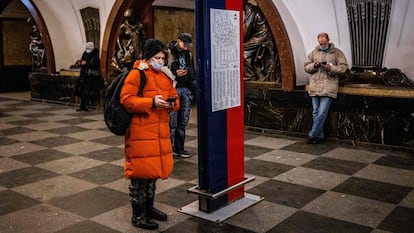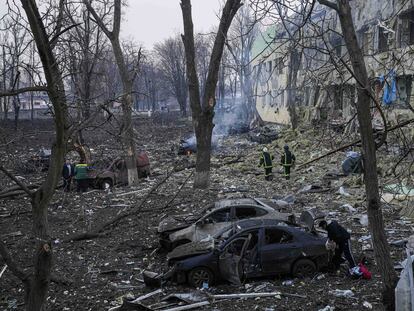The Kremlin takes the first steps to isolate the Russian internet from the rest of the world
Moscow is prepared to disconnect the country from cyberspace. Though the authorities officially deny the initiative, leaked messages suggest that it will begin to roll out the strategy on the government’s websites this Friday

Since the invasion of Ukraine began, there have been rumors that Russia could decide to disconnect its citizens from the rest of the internet. On Monday, messages were leaked from the vice secretary of Digital Development, Andrei Chemenko, who directed government agencies to relocate all their networks to within the national territory before Friday. Amidst the backlash caused by the news, the Kremlin denied that it planned to isolate Russian cyberspace from the rest of the world, though it did not deny that it planned to do so with the government’s own websites.
Moscow already has the technical capacity to drop ties with the rest of the internet. Its sovereign internet project, known as RuNet, was legally enabled in 2019 and has already proved successful in tests. RuNet allows for the internet to continue working in the country, redirecting all traffic to national servers controlled by state authorities – meaning that the Kremlin will determine what can be accessed. In practice, that means that Russians will not be able to access webpages from outside the country.
Three measures stand out from the strategy proposed in Chernenko’s emails. The first involves changing services hosted outside the country to servers in the country; the second is to erase from websites all JavaScript code obtained from external sources; and the third involves changing addresses to servers within the Russian Domain Name System (DNS). The last measure translates each website’s alphanumeric protocols into legible names that can be typed into a browser. In a global network, websites based elsewhere are still accessible through the DNS, but breaking with the rest of the world requires an independent DNS. That measure raises fears of disconnection.
What could motivate Moscow to completely disconnect itself from the rest of the world? “RuNet hasn’t been enabled because it would cause a problem for all the countries that do business outside the country. The project’s objective was actually to have an alternative when Russia felt that its cyberspace was threatened. If it suddenly received a lot of powerful cyberattacks that affected critical infrastructure and governmental websites, it would make sense to press the red button,” says Andrea G. Rodríguez, head researcher for emerging technologies at the European Policy Center in Brussels.
The effect of a total shutdown on Russian citizens can’t be underestimated. “Moscow should think strategically about whether RuNet could cause people to get upset and further increase the pressure of public opinion and protests,” notes Raquel Jorge, technology policy analyst at the Elcano Royal Institute.
Russia is not alone in its interest in controlling cyberspace. China has spent more than 20 years working on its own closed internet project, though its model is different: it involves massive censorship rather than independence of the global information nodes. “Beijing doesn’t disconnect from the web. It puts up a large amount of filters so that a lot of people are monitoring what can and can’t get through. Today, as far as we know, China doesn’t have the technical capacity that Russia has to disconnect from the world,” Rodriguez explains.
Iran is also preparing a law to isolate the country’s internet from the rest of the world. At the end of February it was debated in parliament, where it received criticism from some representatives. It is expected to be approved this month. The United Nations High Commissioner for Human Rights has urged Tehran to reconsider its posture.
The internet’s red button
The term RuNet was popularized in the 1990s by one of the first Russian bloggers, Raffi Aslanbekov. Currently, only certain social networks and independent media outlets remain blocked. On Friday, all Meta social networks were included in the package. (Facebook had already been blocked, though Instagram and Whatsapp remained accessible.) The Kremlin has had a panic button for a long time. “Disconnection has been possible for three or four years, but applying it is another matter,” says Stanislav Sharikov, technology director at the NGO Roskomsvoboda. As things stand now, “without large disturbances or massive protests, disconnecting the internet wouldn’t make sense, though the option is on the table if the protests get stronger and the internet contributes to them,” he adds.
The “Russian island” has been official since May 1, 2019, when Putin signed the law that put the Russian internet beneath state control. The reform came after intense debate, but it passed the State Duma with 334 votes for the measure and 47 against it. One of the norm’s authors was representative Andrei Lugovoi, who justified the initiative by quoting Edward Snowden, the ex-CIA and NSA employee who received asylum in Russia after his contributions to WikiLeaks.
The initiative requires internet service providers to install government software that allows authorities to inspect the data packets that webpages send to users without authorization from telecommunications companies. This has allowed the government to block banned websites, from LinkedIn and Facebook to independent media outlets such as Dozhd and Meduza, and even to slow down traffic to certain services as a punishment for giving a platform to “undesirable organizations.” Twitter, for example, has been slowed down since January 2021 because of its role in the protests against the detention of activist Alexei Navalni.
The idea of a closed internet in Russia emerged in 2014, when the founder of the chat app Telegram, Pável Durov, abandoned his company after a confrontation with the government. That year, the Ministry of Telecommunications had unsuccessfully attempted to disconnect the network. He also unsuccessfully tried to block the Russian alternative to WhatsApp. Economic issues in the company led Durov to make an agreement with the authorities in 2020, allowing the Federal Security Service (SFS) access to the network in their investigations in exchange for operating in the country. Telegram has become one of the principal channels of information in Belarus and Russia amidst the repression of press and protesters.
How to get around the shutdown
Both the Internet Protection Society and Roskomsvoboda have offered citizens “legal alternatives to unblock blocked websites.” One method is to install Virtual Private Network (VPN) applications and extensions, which encrypt and resend content using private networks located in other countries. Many of those, however, have been eliminated or fined by authorities thanks to a 2018 law that punishes VPN services for allowing access to prohibited portals. That same year, the government created a norm that forced “information dissemination services” to have their servers in Russia in case the police have to access their messages.
The NGO also recommends installing a series of applications that mask users’ IP address and encrypt information. Russian authorities banned one of those services, Tor, last February.
“Wasn’t a VPN a panacea? Unfortunately, no,” the organization Klimarev says. “Without going into technical details, a classic VPN is very easy to identify and block, but there are other tools that have demonstrated their efficacy in China, Iran, Belarus and other countries,” the NGO adds.
It’s not yet clear how much Russians would be able to get around the restrictions of a complete blackout. “If they isolate the internet, it won’t work sell, though some services, like banks, transfers and payments, will remain active. Those companies have duplicated their infrastructure in Russia,” Sharikov from Roskomsvoboda says. “There will probably be some connection with other countries. If they shut down the internet, not everyone will be able to connect to the outside, but people who have some technical knowledge will.”
Tu suscripción se está usando en otro dispositivo
¿Quieres añadir otro usuario a tu suscripción?
Si continúas leyendo en este dispositivo, no se podrá leer en el otro.
FlechaTu suscripción se está usando en otro dispositivo y solo puedes acceder a EL PAÍS desde un dispositivo a la vez.
Si quieres compartir tu cuenta, cambia tu suscripción a la modalidad Premium, así podrás añadir otro usuario. Cada uno accederá con su propia cuenta de email, lo que os permitirá personalizar vuestra experiencia en EL PAÍS.
¿Tienes una suscripción de empresa? Accede aquí para contratar más cuentas.
En el caso de no saber quién está usando tu cuenta, te recomendamos cambiar tu contraseña aquí.
Si decides continuar compartiendo tu cuenta, este mensaje se mostrará en tu dispositivo y en el de la otra persona que está usando tu cuenta de forma indefinida, afectando a tu experiencia de lectura. Puedes consultar aquí los términos y condiciones de la suscripción digital.
More information
Últimas noticias
NASA discovers Titan doesn’t have an ocean, but a ‘slushy ice layer’ that increases possibility of life
Innocence lost in the forest of the child soldiers: ‘Each leader of the armed group had his girls’
‘Fallout’ or how the world’s largest company turned an anti-capitalist apocalyptic Western into a phenomenon
From inflation to defending migrants: Eileen Higgins and Zohran Mamdani inaugurate the new Democratic resistance against Trump
Most viewed
- ‘El Limones’ and the growing union disguise of Mexican organized crime
- Christian Louboutin: ‘Young people don’t want to be like their parents. And if their parents wear sneakers, they’re going to look for something else’
- The low-cost creative revolution: How technology is making art accessible to everyone
- ‘We are dying’: Cuba sinks into a health crisis amid medicine shortages and misdiagnosis
- Liset Menéndez de la Prida, neuroscientist: ‘It’s not normal to constantly seek pleasure; it’s important to be bored, to be calm’











































